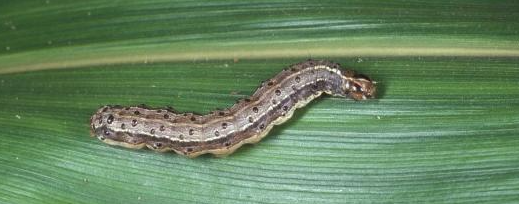
by Sheila Dunning | Nov 4, 2021
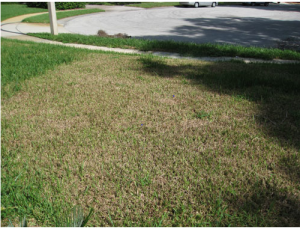
Chewing caterpillar damage on St. Augustinegrass Photo by: Steven Arthurs, UF
Tropical sod webworm larvae are destructive pests of warm season turfgrasses in the southeastern U.S. especially in the fall. Commonly referred to as a worm, they are truly caterpillars, the larvae of a moth. Larval feeding damage reduces turfgrass aesthetics, vigor, photosynthesis and density, which is very evident on finer-bladed grasses such as bermudagrass and zoysiagrass. Feeding damage is possible on all grass types however. Adults, a dull brown colored moth about ¾ inch long, rest in sheltered and shrubby areas during the day and are active at dusk. Females deposit clusters of 10-35 eggs on the upper surface of grass blades. The eggs hatch in 3-4 days and develop from a 1 mm long caterpillar to one over 11 mm long through six instars within 21 to 47 days, depending on temperature. Larval feeding occurs at night, leaving the grass looking ragged, shortened and missing.
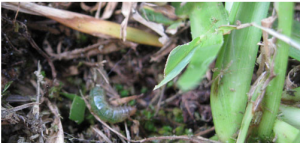
Sod webworm on soil surface
Photo by: Steven Arthurs, UF
Control should be against damaging larvae, not the flying moths. However, insecticidal soap applications to moth harboring areas can reduce re-population frequency. Soil-drenching soap flushes can be used to find the caterpillars, especially in dry and hot grass areas. Bacterial-based insecticides, such as Bt, Bacillus thuringiensis var. kurstaki or Spinosad, will control sod webworm caterpillars without impacting beneficial species as long as they are applied with each flush of grass growth.
Fall armyworms are also active when the weather turns cooler. They feed any time of the day or night, but are most active early in the morning or late in the evening. The 1 ½ inch long gray and white moth lays about 1,000 eggs in multiple masses on any vegetation. Two to 10 days later, the small caterpillar hatches and begins to grow to nearly 2 inches long over a two week period. The fall armyworm is easily recognized by its dark head marked with a distinct pale-colored inverted Y and the long black stripe running along each side of its body. These aggressive feeders “march” rapidly across grassed areas consuming every above-ground plant part. While bacterial-based insecticides will reduce the numbers, control of armyworms usually requires synthetic insecticides.
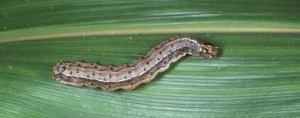
Armyworm
Photo by: Jim Castner, UF
The good news is that grass “worms” can be controlled and the blades will grow back. The damage may be devastating to see, but usually not a permanent problem.
by Evan Anderson | Oct 14, 2020
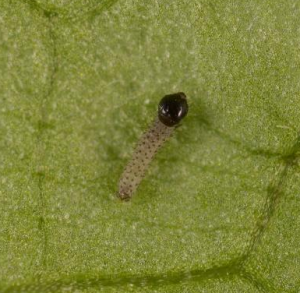
A newly hatched armyworm –photo by Lyle Buss
With a population that never seems to quite disappear in North Florida, the armyworm is a caterpillar pest of many plants. There are four types found in our area: fall, southern, yellow-striped, and beet armyworms. The caterpillars pupate into moths, which breed roughly from April to December, but warmer weather may lead to them being sighted even in the middle of winter. Adult moths, which are relatively nondescript and gray-brown in appearance, lay masses of 100-200 eggs on plants. Young armyworms are tiny and very difficult to detect, often hiding during the brightest parts of the day.
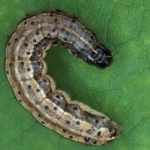
A fall armyworm. –photo by J L Castner
The armyworm grows to a length of about 1 ¼ inches, taking about two weeks to reach its full size. The caterpillar builds a cocoon in the soil and pupates into a moth, living another one to three weeks. With its ability to eat a broad range of plants, this can lead to large populations of these insects in a relatively short time.
Armyworms seem to prefer eating grasses (especially Bermudagrass in lawns), but will chew on almost anything in their path. They have been observed eating citrus trees, tobacco, cotton, strawberries, and even weeds like pigweed and nutsedge. A hungry armyworm might even turn on its fellow caterpillars, eating them as well if they are too close. When large numbers of these pests are present, the damage they do to surrounding foliage can be stark. Young caterpillars may skeletonize leaves, while older larvae will make holes in leaves or defoliate plants fully.
Years with an abundance of wet or humid weather seem to help armyworms reproduce. Armyworms seem to be attracted to newly established turf, and heavy fertilization of turfgrass in late summer can also cause populations to build. Scout for them
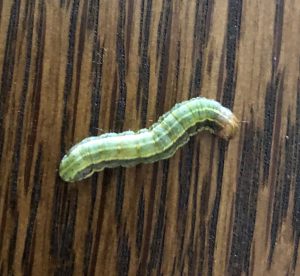
A beet armyworm. –photo by Serena Robison
during cooler hours of the day, or when it is overcast or rainy. Mixing a tablespoon of dishwashing soap in a gallon of water and pouring it over a four-square foot area will cause insects to crawl to the surface – do this if damage is present and armyworms are suspected. For lawns, treatment at the first sight of damage may help, though a lawn may very well survive an attack by armyworms. If chemical control is necessary, there are numerous options. Products containing the active ingredients Bacillus thuringiensis, acephate, bifenthrin, carbaryl, permethrin, spinosad, and others have all been labeled for use on armyworms.
For more information, see our EDIS publication on fall armyworm at https://edis.ifas.ufl.edu/in255 or contact your local Extension office.
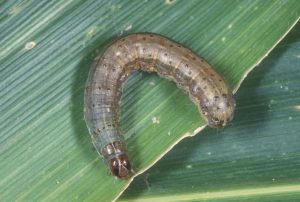
by Sheila Dunning | Aug 17, 2017
If you are one of the many that have taken advantage of the frequent rain in order to establish a new lawn, keep an eye open for “grass worms”. Though truly caterpillars, not worms, these destructive, chewing insects can wreak havoc on new sod.

Sod Webworm Photo by: Lyle Buss UF
Tropical sod webworm larvae are destructive pests of warm season turfgrasses in the southeastern U.S. especially on newly established sod. Larval feeding damage reduces turfgrass aesthetics, vigor, photosynthesis and density, which is very evident on finer-bladed grasses such as bermudagrass and zoysiagrass. Adults, a dull brown colored moth about ¾ inch long, rest in sheltered and shrubby areas during the day and are active at dusk. Females deposit clusters of 10-35 eggs on the upper surface of grass blades. The eggs hatch in 3-4 days and develop from a 1 mm long caterpillar to one over 11 mm long through six instars within 21 to 47 days, depending on temperature. Larval feeding occurs at night, leaving the grass looking ragged, shortened and missing.
Control should be against damaging larvae, not the flying moths. However, insecticidal soap applications to moth harboring areas can reduce re-population frequency if such areas are located. Soil-drenching soap flushes can be used to find the caterpillars, especially in dry and hot grass areas. Bacterial-based insecticides will control sod webworm caterpillars without impacting beneficial species as long as they are applied with each flush of grass growth.
Excessive fertilizing will lead to caterpillar outbreaks in lawns. Newly installed sod is usually rich in nutrients and rapid growing, which makes it very attractive to sod webworms. Grass installation over the summer months should be immediately followed by sod webworm treatment.

Fall Armyworm Photo by: Lyle Buss UF
Fall armyworms are also attracted to newly installed sod. They feed any time of the day or night, but are most active early in the morning or late in the evening. The 1 ½ inch long gray and white moth lays about 1,000 eggs in multiple masses on any vegetation. Two to 10 days later, the small caterpillar hatches and begins to grow to nearly 2 inches long over a two week period. The fall armyworm is easily recognized by its dark head marked with a distinct pale-colored inverted Y and the long black stripe running along each side of its body. These aggressive feeders “march” rapidly across grassed areas consuming every above-ground plant part. While bacterial-based insecticides will reduce the numbers, control of armyworms usually requires synthetic insecticides. Diligent inspection and early pesticide application is critical to establishment of new sod installed during the summer months.
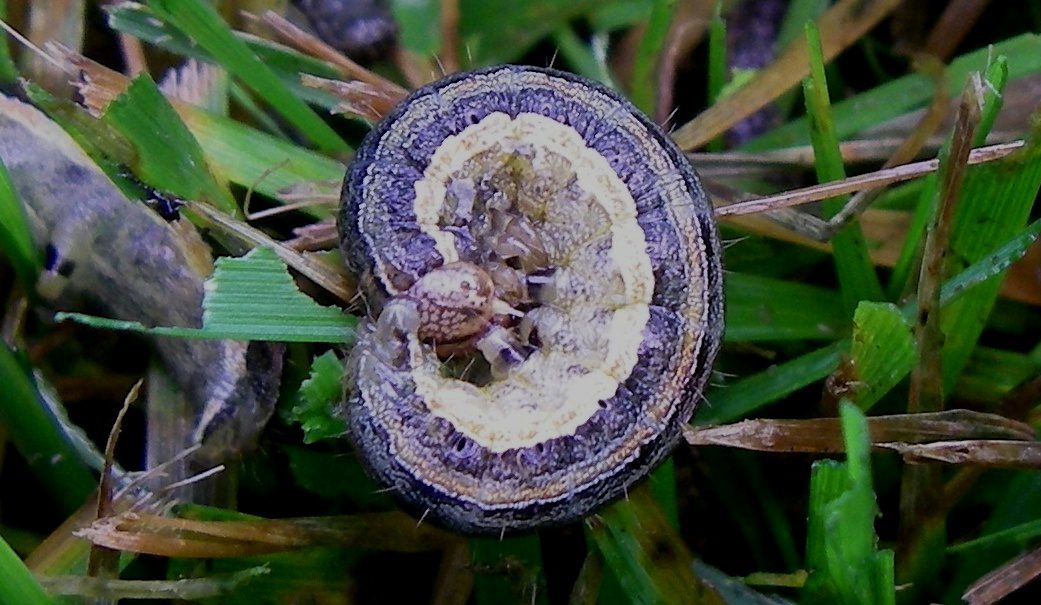
by Matt Lollar | Sep 23, 2015
Armyworms come in a wide range of colors and sizes. A few of the prominent species living in Florida are beet, southern, and fall armyworms. And the term “living” is not an exaggeration, because Florida is one of the lucky states where it is warm enough for armyworms to overwinter. They are the snowbirds that never leave!
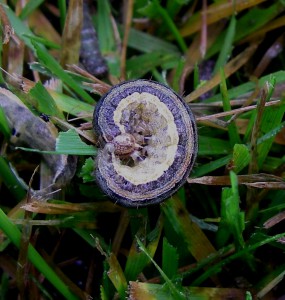
Armyworm damage on a lawn. Credit: Purdue University
Armyworms are notorious for unanticipated invasions. They feed on most turfgrass species and most vegetable crops, but they prefer grassy vegetable crops such as corn. Armyworms feed in large groups and their feeding has been described as “ground moving” in lawns. They feed during cooler times of the day (morning and evening) and they roll up and rest under the vegetative canopy (in the thatch layer in turf and in the base of leaves in vegetables) during the heat of the day.
Armyworms are difficult to control because of their spontaneity. However, in the lawn they hide in the thatch during the heat of the day. Over watering and fertilization can increase the amount of thatch. It is important to follow UF/IFAS guidelines for home lawn management. A good weed control program can also help to deter armyworms, because weeds serve as an alternate food source.
Numerous chemical control options are available, but softer chemicals such as horticultural oils and insecticides containing the bacteria Bacillus thuringiensis are recommended as a first line of defense. Insecticides should be applied in the morning or evening during feeding time. For additional control strategies and basic information please visit the UF/IFAS Armyworm Publication Page.
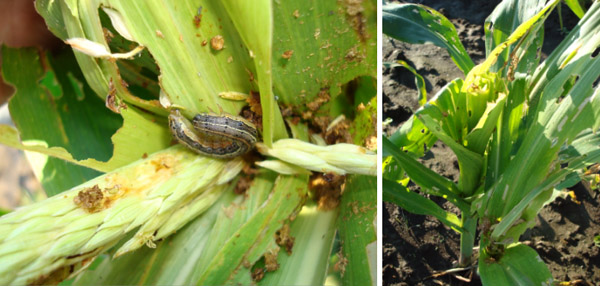
Armyworm feeding on a young corn plant. Credit: University of Illinois













